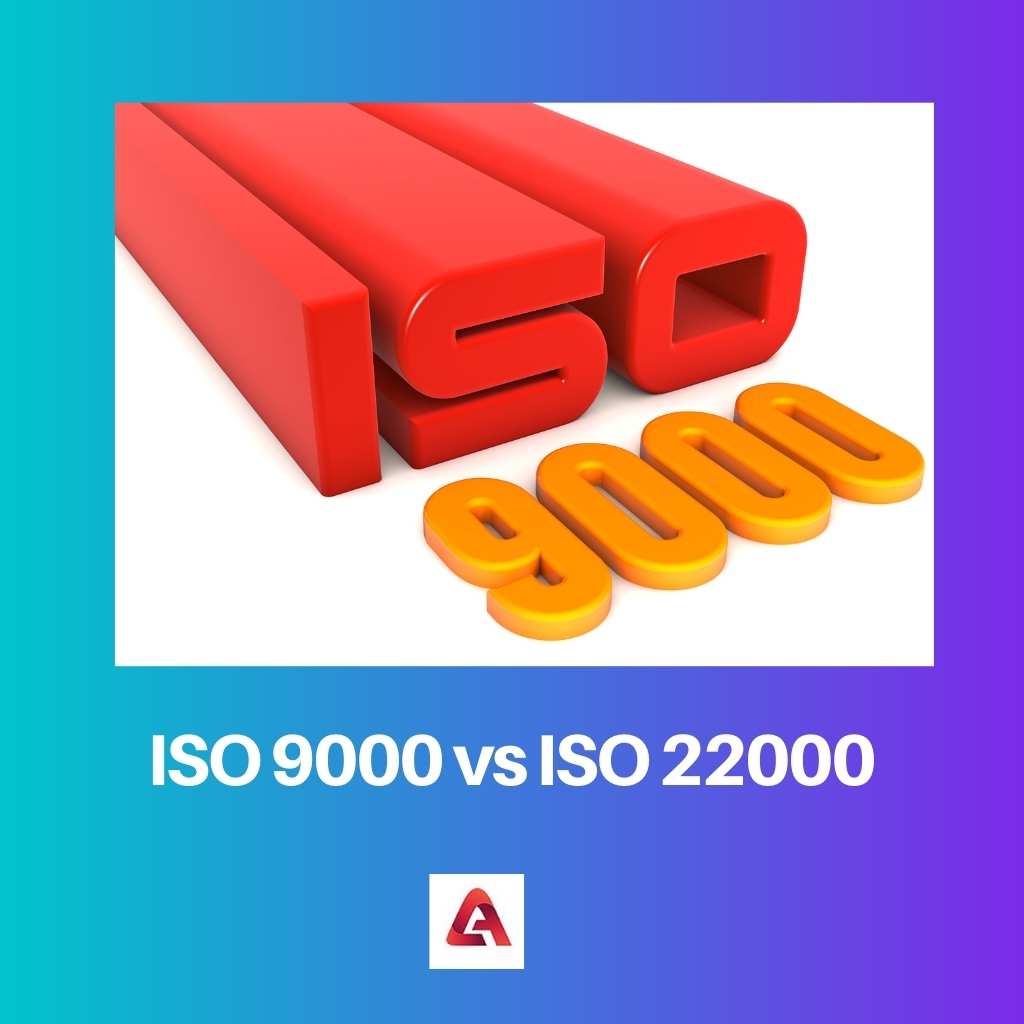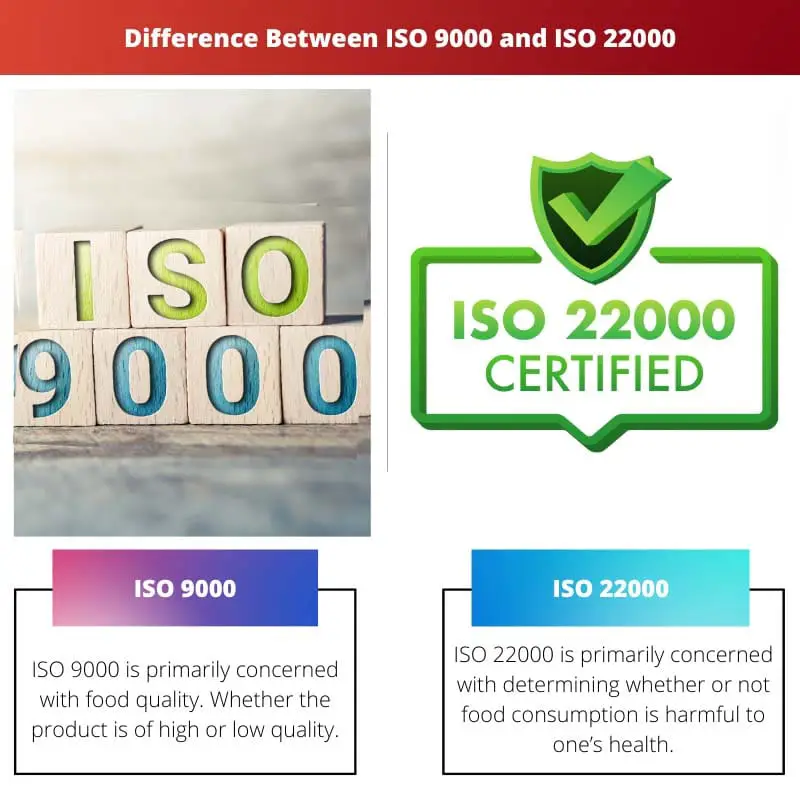Quality Assurance and Management is a publication of the International Organization for Standardization (ISO 9000). Food quality is the primary focus of ISO, 9000-whether the quality is excellent or poor.
The Food Safety Management System, also known as ISO 22000, is a standardized product published by the ISO.
The main focus of ISO 22000 is on whether or not food consumption is harmful to one’s health. This standard aids in guaranteeing the safety of the food.
Key Takeaways
- ISO 9000 is a series of quality management standards applicable to organizations in various industries, while ISO 22000 is a specific standard for food safety management systems.
- ISO 9000 focuses on overall quality management, customer satisfaction, and continuous improvement, whereas ISO 22000 concentrates on ensuring food safety throughout the supply chain.
- Organizations in the food industry may choose to implement both ISO 9000 and ISO 22000 to demonstrate their commitment to quality and food safety.
ISO 9000 vs ISO 22000
ISO 9000 is a standard that is focused on ensuring that a company’s products or services meet customer requirements no matter the product or service being offered. ISO 22000 is specifically created for food safety management. It outlines the requirements for a food safety management system.

Since 1987, the ISO 9000 standard has been in place. As a result, the ISO 9000 standard was originally published in 1987.
The significance of ISO 9000 certification is to maintain and facilitate an effective quality system by assisting firms in successfully documenting the aspects of the quality system.
ISO 9000 is primarily concerned with food safety. Whether the quality is premium or standard.
ISO 22000 is a new standard. It was initially released in 2005. Every company that operates from farm to fork and interacts with the food chain benefits from ISO 22000 certification.
Customers trust companies that have received ISO 22000 accreditation. ISO 22000 is primarily concerned with whether or not food consumption is harmful to one’s health.
This criterion ensures that the food is safe to eat.
Comparison Table
| Parameters of Comparison | ISO 9000 | ISO 22000 |
|---|---|---|
| Basic | Quality Assurance and Management | Food Safety Management System |
| First Published in | 1987 | 2005 |
| Used by | Every company adhering to an efficient quality system | Food chain |
| Focuses on | Quality of food | The safety level of food |
| Version | Older | Newer |
What is ISO 9000?
ISO 9000 is primarily concerned with food quality. Whether the product is of high or low quality.
Some of the ideas related to ISO 9000 management include holding individuals accountable, involving participants in the improvement process, valuing people’s potential, and many others.
This standard supports the production of goods and services by ensuring that their quality is acceptable in a global context. Since 1987, ISO 9000 has been in use.
As a result, the first version of ISO 9000 was issued in 1987. The International Organization for Standardization’s publication ISO 9000 stands for Quality Assurance and Management.
ISO 9000 is defined as a set of standards that encompasses all of the internationally recognized quality management and assurance standards.
The importance of ISO 9000 certification is to maintain and facilitate an effective quality system by assisting firms in successfully documenting the aspects of the quality system.
What is ISO 22000?
ISO 22000 is primarily concerned with determining whether or not food consumption is harmful to one’s health. This standard aids in the assurance that the food is safe to eat.
Relationship management, customer focus, improvement, leadership, evidence-based decision making, the process approach, and so on are some of the key principles connected with ISO 22000 management.
ISO 22000 is a relatively new standard. In 2005, it was published for the first time.
Every company that works from farm to fork and interacts with the food chain understands the value of ISO 22000 certification.
Customers have more faith in companies that have earned the ISO 22000 accreditation.
The Food Safety Management System, also known as ISO 22000, is a publication of the ISO, or International Organization for Standardization.
In the international market, ISO 22000 is referred to as a recognized standard that is a blend of HACCP and ISO9001.
As a result, it has a correct approach to food safety management as well as the assurance of food safety at all levels.
Main Differences Between ISO 9000 and ISO 22000
- ISO 9000 refers to the Quality Assurance and Management, which is a publication of the International Organization for standardization. On the other hand, ISO 22000 refers to the Food Safety Management System, which is a publication of ISO or International Organization for standardization.
- ISO 9000 is characterized as a set that combines all the recognized standards in the international market for the management and assurance of quality. This standard encourages the goods and services production make their quality acceptable in the global scenario. On the other hand, ISO 22000 is referred to as a recognized standard in the international market which is a combination of HACCP and ISO9001. Thus, it has a proper approach towards the safety management of food along with the assurance of the safety of food at all levels.
- ISO 9000 has been in existence since 1987. Thus, in 1987 the first version of the ISO 9000 was published. On the other hand, ISO 22000 has a recent existence. It was published for the first time in 2005.
- The importance of the certification of ISO 9000 is to maintain and facilitate an efficient quality system helping the organizations to document the elements of the quality system effectively. On the other hand, the importance of the certification of ISO 22000 is applied to every company which works from farm to fork and deals with the food chain. Companies having ISO 22000 certification gather the confidence of the customers in their products.
- ISO 9000 mainly focuses on the quality of food. Whether the quality is of premium or ordinary quality. On the other hand, ISO 22000 mainly focuses whether the consumption of food is hazardous to health or not. This standard helps in ensuring that the food is safe for consumption.
- Some of the principles associated with the management of ISO 9000 are it makes people accountable, engages participants in the improvement process, ensures that people’s potential is valued, and many more. On the other hand, Some of the key principles associated with the management of ISO 22000 are relationship management, customer focus, improvement, leadership, decision making based on evidence, the process approach, etc.

- http://ur.aeu.edu.my/id/eprint/747
- http://search.ebscohost.com/login.aspx?direct=true&profile=ehost&scope=site&authtype=crawler&jrnl=10129367&AN=83536195&h=qPjag7XA0sWdOSnyebikhoaB4oXZUo2ZXPCZrFzVxZXZoatNtjA4%2Bx7mg%2BOfNKj3v0twkvuF1Z1aWtVMBlMUvA%3D%3D&crl=c
